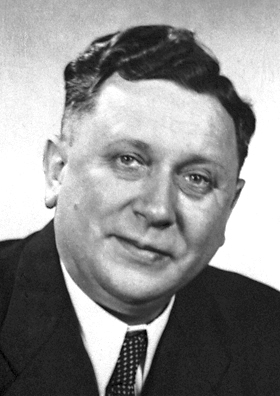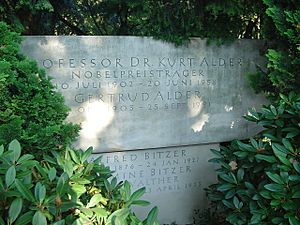Kurt Alder facts for kids
Quick facts for kids
Kurt Alder
|
|
|---|---|
 |
|
| Born | July 10, 1902 Königshütte, Silesia, Germany
|
| Died | 20 June 1958 (aged 55) |
| Nationality | German |
| Alma mater | University of Berlin University of Kiel |
| Known for | Diels-Alder reaction |
| Awards | Nobel Prize for Chemistry (1950) |
| Scientific career | |
| Fields | Organic chemistry |
| Institutions | I G Farben Industrie, University of Cologne |
Kurt Alder (born July 10, 1902 – died June 20, 1958) was a German chemist. He won the Nobel Prize in Chemistry in 1950. He is famous for discovering the "Diels-Alder reaction" with his teacher, Otto Diels. This reaction is a very important way to create new chemical compounds.
Contents
About Kurt Alder
Kurt Alder was born in an industrial area called Königshütte. This place is now known as Chorzów in Poland. He went to school there when he was young.
Early Life and Education
In 1922, Kurt Alder left Königshütte. This was because the area became part of Poland. He then started studying chemistry. He went to the University of Berlin. Later, he studied at the University of Kiel. He earned his PhD degree in 1926. His teacher and supervisor was Otto Diels.
Working as a Chemist
In 1930, Alder became a chemistry reader at the University of Kiel. He was promoted to lecturer in 1934. In 1936, he moved to Leverkusen. There, he joined a company called I G Farben Industrie. He worked on making synthetic rubber.
In 1940, he became a professor. He taught Experimental Chemistry and Chemical Technology. This was at the University of Cologne. He also became the director of the Institute of Chemistry there. Even with many challenges in Europe at that time, he kept working. He continued to research how to create organic compounds. He published over 151 scientific papers about his work.
The Nobel Prize and His Legacy
Kurt Alder received many awards during his life. The most famous one was the 1950 Nobel Prize in Chemistry. He shared this prize with his former teacher, Otto Diels. They won for their important work on the Diels–Alder reaction.
This chemical reaction is named after them. It is used to make many different substances. For example, the insecticide called aldrin is made using this reaction. A crater on the Moon is also named after him. It is called Alder.
See also
 In Spanish: Kurt Alder para niños
In Spanish: Kurt Alder para niños


